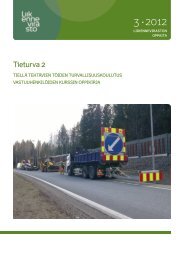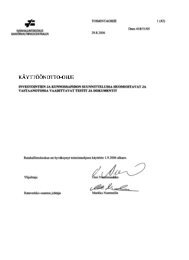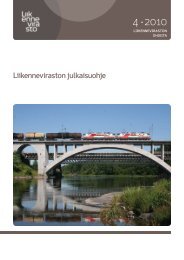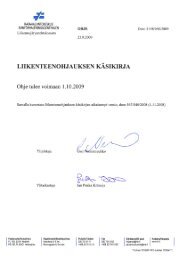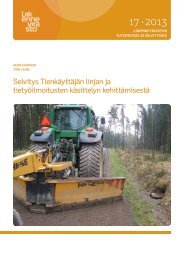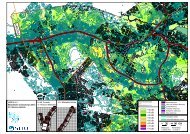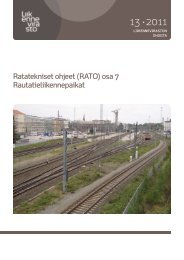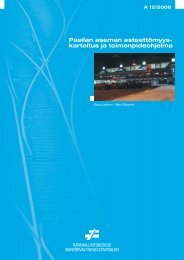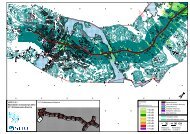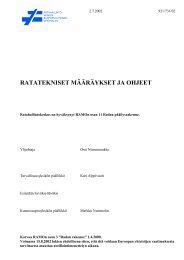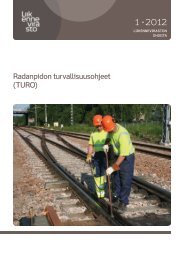Deformation behaviour of railway embankment ... - Liikennevirasto
Deformation behaviour of railway embankment ... - Liikennevirasto
Deformation behaviour of railway embankment ... - Liikennevirasto
You also want an ePaper? Increase the reach of your titles
YUMPU automatically turns print PDFs into web optimized ePapers that Google loves.
73<br />
There are two test methodologies for conducting repeated load triaxial tests: the<br />
constant confining pressure test (CCP) and the variable confining pressure test (VCP).<br />
Both the CCP test and the VCP test are described into more detail in Chapter 8.<br />
5.2 Models based on resilient modulus and Poisson’s ratio<br />
5.2.1 Definition <strong>of</strong> resilient modulus and Poisson’s ratio<br />
In the traditional theories <strong>of</strong> elasticity, the elastic properties <strong>of</strong> a material are defined<br />
by the modulus <strong>of</strong> elasticity (E) and Poisson's ratio (ν), which are material constants.<br />
A similar approach has been widely used in dealing with granular materials, but the<br />
modulus <strong>of</strong> elasticity is replaced with the resilient modulus to indicate the nonlinearity,<br />
i.e. the dependence on the stress level, <strong>of</strong> the <strong>behaviour</strong>. For repeated load<br />
triaxial tests with constant confining pressure, the resilient modulus and Poisson's<br />
ratio are defined by<br />
M r<br />
v<br />
( )<br />
∆ σ − σ<br />
1 3<br />
= , (Eq. 5.2.1:1)<br />
ε1,<br />
r<br />
ε<br />
3, r<br />
= − , (Eq. 5.2.1:2)<br />
where<br />
ε<br />
1, r<br />
M r = resilient modulus,<br />
ν = resilient Poisson's ratio,<br />
∆ = indicates "change in",<br />
σ 1 , σ 3 = major and minor principal stress,<br />
ε 1,r , ε 3,r = recoverable axial and horizontal strain.<br />
This method <strong>of</strong> calculating the resilient parameters is the same as would apply to an<br />
isotropic, linear-elastic material under uniaxial stress conditions. When cyclic<br />
confining pressure is applied, the generalized Hooke's law is employed for 3-<br />
dimensional stress-strain relationships <strong>of</strong> an isotropic, linear-elastic material. The<br />
resilient modulus and Poisson's ratio are then derived from<br />
1, r<br />
( σ<br />
1<br />
−σ<br />
3<br />
) ⋅ ∆( σ<br />
1<br />
+ 2σ<br />
3<br />
)<br />
⋅ ∆( σ<br />
1<br />
+ σ<br />
3<br />
) ⋅ 2ε<br />
3, r<br />
⋅ ∆σ<br />
3<br />
∆<br />
M<br />
r<br />
=<br />
, (Eq. 5.2.1:3)<br />
ε<br />
ν =<br />
∆σ<br />
ε<br />
3<br />
1 3, r 3 1, r<br />
. (Eq. 5.2.1:4)<br />
3, r<br />
− ∆σ<br />
ε<br />
1, r<br />
( σ + )<br />
2∆σ<br />
ε − ε ∆ σ<br />
1<br />
3<br />
Many researchers have tried to outline mathematical procedures for describing the<br />
stress dependence <strong>of</strong> the resilient modulus using various stress variables. The great<br />
majority <strong>of</strong> the models found in the literature are based on simple curve fitting<br />
procedures using the data from laboratory triaxial testing.




